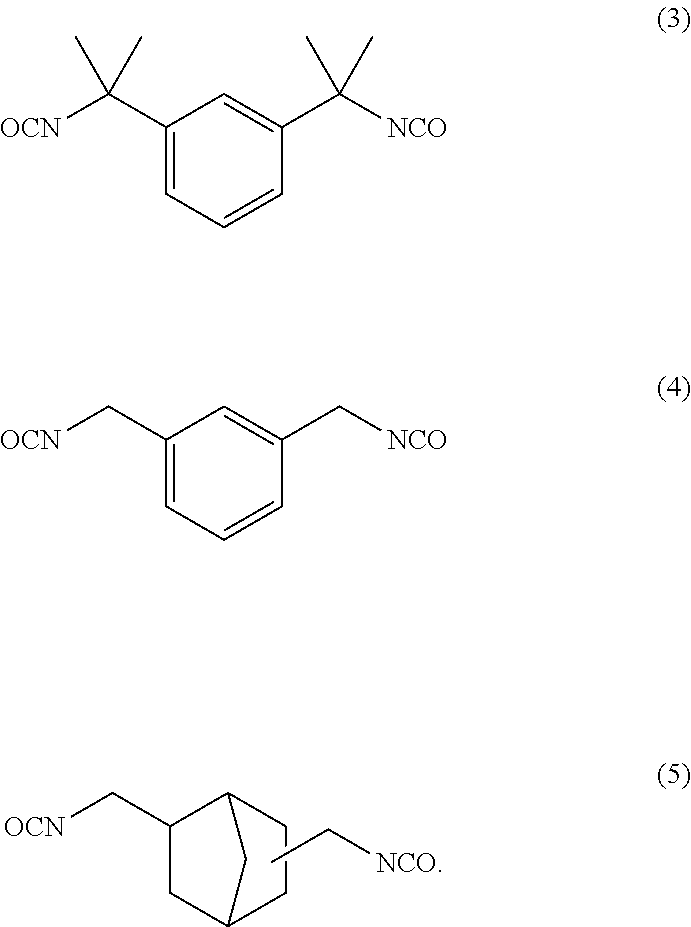Dental polymerizable monomer compositions
a polymer composition and polymer technology, applied in the field of dental polymer compositions, can solve the problems of poor strength obstructing the application of resins to sites subjected to high stress, insufficient mechanical properties of cured composite resins, etc., and achieves high rigidity, high toughness, and appropriate viscosity.
- Summary
- Abstract
- Description
- Claims
- Application Information
AI Technical Summary
Benefits of technology
Problems solved by technology
Method used
Image
Examples
production example 1
[0218]A thoroughly dried 1-liter four-necked flask equipped with a stirring blade and a thermometer was loaded with 270.0 g (2.325 mol) of HEA, 0.55 g of DBTDL (0.1 wt % relative to the total weight of hydroxyethyl acrylate and TMXDI) and 0.28 g of BHT (0.05 wt % relative to the total weight of HEA and TMXDI). The mixture was stirred to uniformity and was thereafter heated to 60° C. Subsequently, 284.0 g (1.163 mol) of TMXDI was added dropwise over a period of 1 hour. The dropwise addition was accompanied by an increase in inside temperature due to the reaction heat, and thus the rate of the dropwise addition was controlled so that the temperature did not exceed 80° C. After the whole amount had been added dropwise, the reaction was performed for 10 hours while keeping the reaction temperature at 80° C. During this process, the progress of the reaction was tracked by HPLC analysis to determine the end point of the reaction. The product was discharged from the reactor. In this manner...
production examples 2 to 8
[0219]Urethane acrylates were synthesized from hydroxyacrylates and diisocyanates illustrated in Table 1 in the same manner as in Production Example 1.
TABLE 1HydroxyacrylatesDiisocyanatesPro. Ex. 1Pro. Ex. 2Pro. Ex. 3Pro. Ex. 4Pro. Ex. 5Pro. Ex. 6Pro. Ex. 7Pro. Ex. 8Viscosity(mPa · sProducts(65° C.))Pro. Ex. 11670Pro. Ex. 21800Pro. Ex. 3 410Pro. Ex. 4 700Pro. Ex. 5 570Pro. Ex. 6 930Pro. Ex. 71770Pro. Ex. 81900
example 1
[0220]10.0 g (21.3 mmol) of the urethane acrylate obtained in Production Example 1 and 4.53 g (15.8=1) of TEGDMA were added into a container. The mixture was stirred to uniformity at 50° C. to give a dental polymerizable monomer composition. In this case, the urethane acrylate from Production Example 1 had two acryloyl groups and TEGDMA had two methacryloyl groups. Thus, the proportion of the number of the acryloyl groups present in the urethane acrylate (A), namely, the urethane acrylate from Production Example 1 was 57% relative to the total number of the polymerizable groups in the dental polymerizable monomer composition, and the ratio of the acryloyl groups to the methacryloyl groups in the composition was 57:43.
[0221]73 mg (0.5 wt %) of CQ and 73 mg (0.5 wt %) of DMAB2-BE were added to 14.53 g of the dental polymerizable monomer composition, and the mixture was stirred to uniformity at room temperature to give a monomer solution. A cured product of the monomers was subjected t...
PUM
| Property | Measurement | Unit |
|---|---|---|
| viscosity | aaaaa | aaaaa |
| reaction temperature | aaaaa | aaaaa |
| reaction temperature | aaaaa | aaaaa |
Abstract
Description
Claims
Application Information
 Login to View More
Login to View More - R&D
- Intellectual Property
- Life Sciences
- Materials
- Tech Scout
- Unparalleled Data Quality
- Higher Quality Content
- 60% Fewer Hallucinations
Browse by: Latest US Patents, China's latest patents, Technical Efficacy Thesaurus, Application Domain, Technology Topic, Popular Technical Reports.
© 2025 PatSnap. All rights reserved.Legal|Privacy policy|Modern Slavery Act Transparency Statement|Sitemap|About US| Contact US: help@patsnap.com



